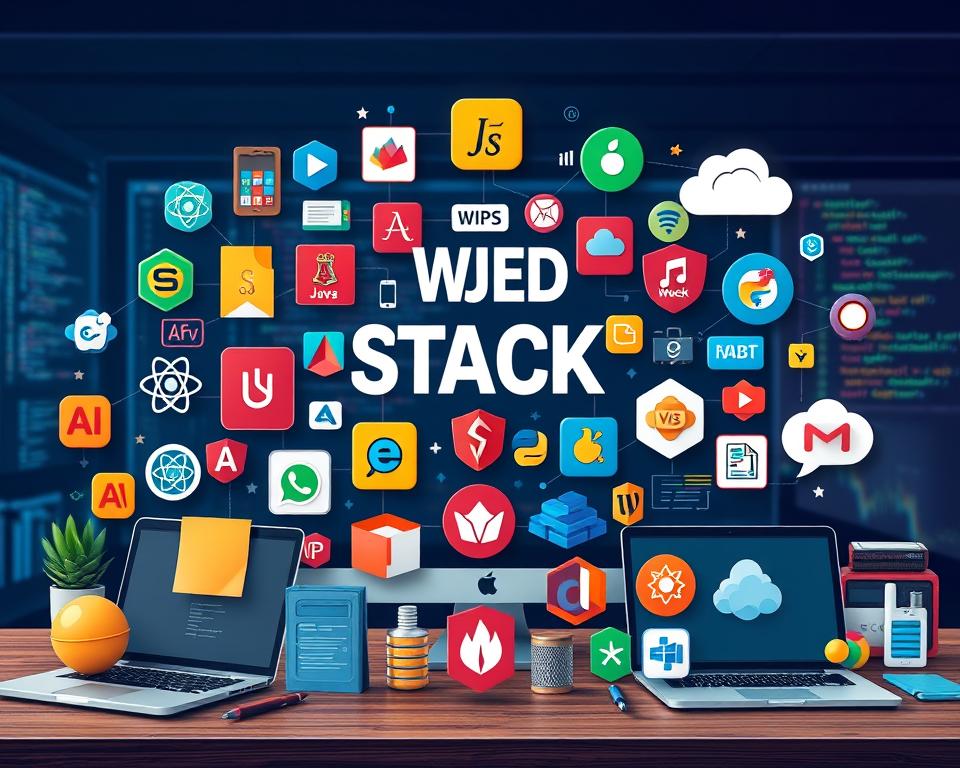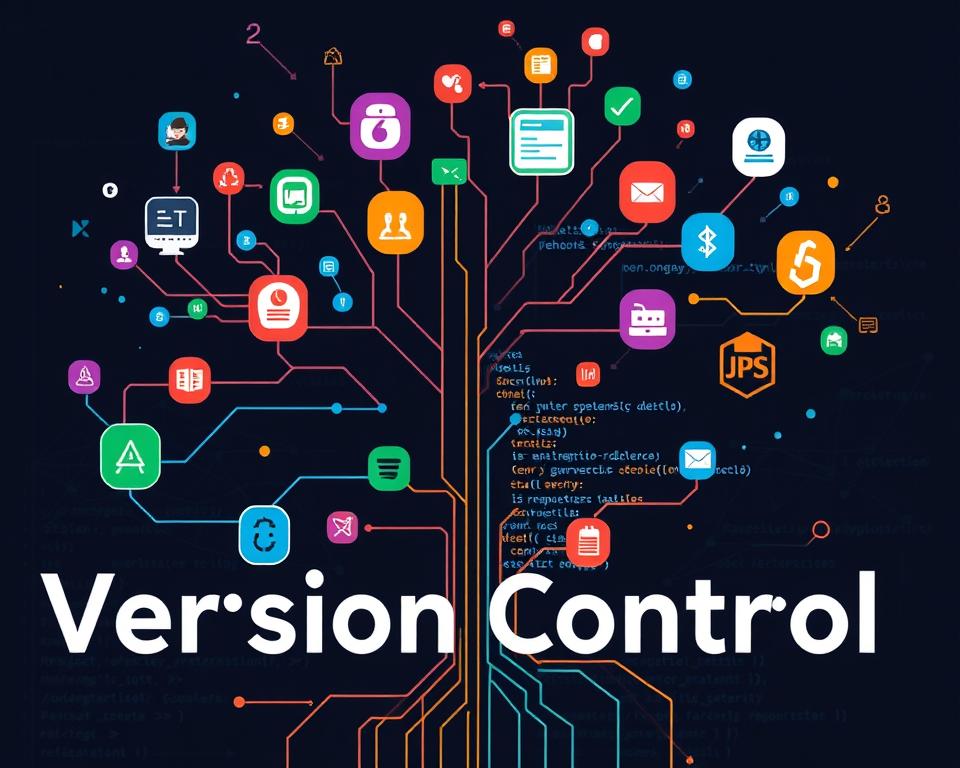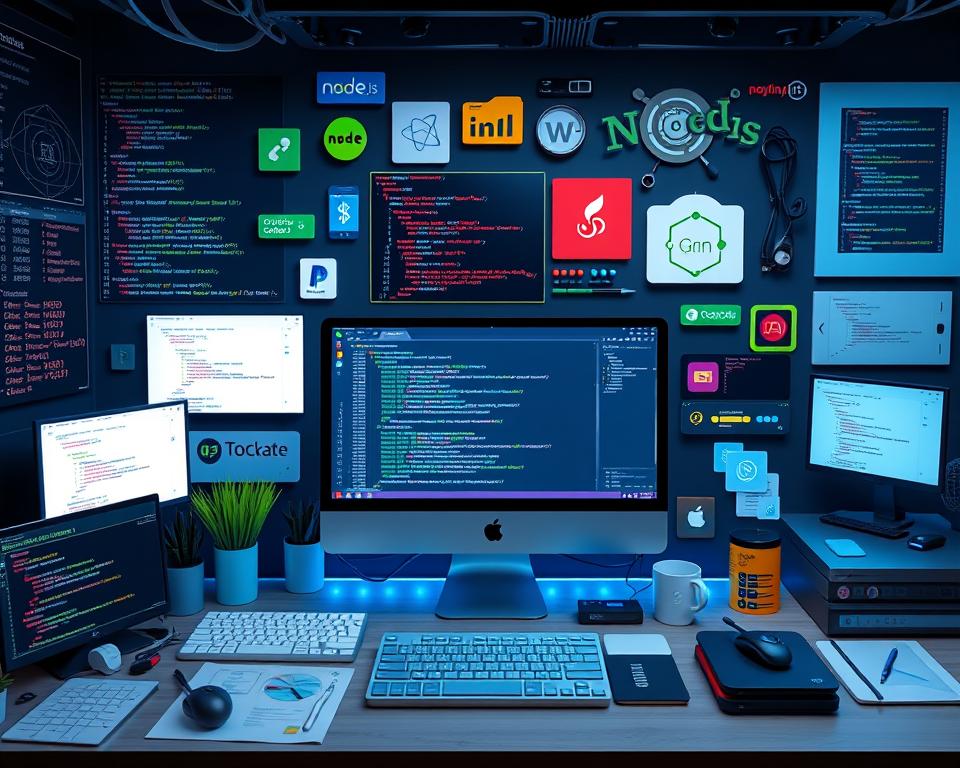The world of web development is always changing. Being able to mix front-end and back-end tech is key. Full stack development lets you master both sides, changing how we build web apps.
This article looks at the top tools for full stack web development. We cover front-end and back-end tech, version control, and how to deploy apps.
Table of Contents
Key Takeaways
- Discover the essential tools and technologies for full stack web development
- Understand the role of front-end and back-end development in the full stack approach
- Explore the significance of version control systems and repository management tools
- Learn about the popular front-end frameworks and libraries for modern web development
- Familiarize yourself with the leading back-end development tools and frameworks
Understanding Full Stack Development in Modern Web Development
In today’s fast-changing web world, full stack development is key. A full stack developer knows both front-end and back-end web tech. They can handle the whole web development process, making complete and connected web apps.
Front-end vs Back-end Development Explained
Front-end development is about the parts of a web app users see and interact with. It uses HTML, CSS, and JavaScript for good looks and ease of use. Back-end development, however, is about the server-side stuff, like data management and the app’s backbone.
The Role of Full Stack Developers Today
Full stack developers are vital in today’s web projects. They connect the front-end and back-end, making sure everything works smoothly. They can do everything from designing interfaces to setting up server-side functions. This makes them essential for creating complete solutions that meet business and user needs.
As web development keeps changing, full stack developers are more important than ever. They drive the creation of new and useful web apps that meet today’s diverse needs.
Essential Code Editors and IDEs for Full Stack Development
In full stack web development, the right code editor or IDE is crucial. These tools help code efficiently and improve the development experience. Let’s look at the top code editors and IDEs that full stack developers use.
Visual Studio Code: A Versatile Code Editor
Visual Studio Code, made by Microsoft, is a favorite among full stack developers. It has a wide range of features, including integrated development environment tools. It supports many programming tools and software development languages, making it great for productivity.
Sublime Text: A Lightweight Powerhouse
Sublime Text is a fast and customizable code editor loved by many. Its simple design and quick performance are key. It also has a big plugin library, making it a top choice for software development.
JetBrains IDEs: Comprehensive Development Suites
The JetBrains family, including IntelliJ IDEA, PyCharm, and WebStorm, is known for its full-featured IDEs. They support a wide range of programming tools and software development needs. They offer advanced code analysis and debugging tools.
Whether you like a simple code editor or a full-featured integrated development environment, these options are great for full stack developers. They help tackle projects efficiently and with ease.
| Code Editor/IDE | Key Features | Supported Languages/Frameworks |
|---|---|---|
| Visual Studio Code |
|
|
| Sublime Text |
|
|
| JetBrains IDEs (IntelliJ IDEA, PyCharm, WebStorm) |
|
|
“The choice of a code editor or IDE can significantly impact a developer’s productivity and overall software development experience.”
Version Control Systems and Repository Management Tools
In web development, teamwork and keeping track of changes are key. Developers use strong tools for managing code, tracking progress, and working together smoothly. At the heart of these tools are version control systems and repository management platforms.
Git and GitHub Fundamentals
Git is the top choice for managing code repositories. It helps developers track changes, go back to earlier versions, and work together on projects. GitHub, a leading Git platform, offers a wide range of tools for version control, hosting code, and team collaboration.
With Git and GitHub, developers can manage their project repositories. This lets many team members work on the same code at the same time. It makes it easy to keep up with changes, merge code, and solve conflicts.
Alternative Version Control Platforms
While Git and GitHub are the leaders, other platforms like Bitbucket and GitLab are also popular. They offer similar features and meet the needs of different development teams and organizations.
- Bitbucket is a cloud-based version control and collaboration platform owned by Atlassian. It integrates well with other Atlassian tools like Jira and Trello.
- GitLab is a full DevOps platform that includes version control, CI/CD, and project management tools. It’s available as a self-hosted or cloud-based solution.
These alternatives give developers more choices. They can pick the version control solution that suits their team’s workflow and project needs.
Frontend Development Frameworks and Libraries
The frontend is key in web development, making sites user-friendly and engaging. Developers use JavaScript frameworks and CSS libraries to build scalable apps. React, Angular, and Vue.js are top choices, each with unique features for complex challenges.
React is a Facebook library known for its component-based design and fast performance. It’s great for creating dynamic interfaces, making it popular for SPAs and mobile apps.
Angular is a Google framework that offers a structured way to develop the frontend. It has a strong dependency injection system, TypeScript support, and a wide range of tools. This makes it ideal for building large, maintainable web apps.
Vue.js is a progressive framework known for its simplicity and efficiency. It has a virtual DOM and easy data binding, making it easy to create interactive interfaces.
CSS frameworks like Bootstrap and Tailwind CSS are also crucial. They offer pre-designed components and grids, speeding up the development of attractive interfaces.
| Framework | Key Features | Use Cases |
|---|---|---|
| React |
|
|
| Angular |
|
|
| Vue.js |
|
|
| Bootstrap |
|
|
| Tailwind CSS |
|
|
Frontend frameworks and libraries are essential in web development. They help developers create dynamic, responsive, and attractive interfaces that work well with backend systems.
Backend Development Tools and Frameworks
Full stack web development needs strong backend tools and frameworks. These are crucial for server-side logic and data management. Node.js, Django, and Ruby on Rails are among the most popular. They offer features and libraries that make development easier, from handling HTTP requests to working with databases.
Popular Server-Side Technologies
- Node.js – A JavaScript runtime environment for server-side scripting. It helps build fast and scalable network applications.
- Django – A high-level Python web framework for rapid development. It’s known for clean, pragmatic design.
- Ruby on Rails – A Model-View-Controller (MVC) framework in Ruby. It’s famous for its “Convention over Configuration” approach, making development efficient.
- Express.js – A minimal and flexible Node.js web application framework. It offers a robust set of features for web and mobile applications.
Database Management Systems
Full stack developers also use strong database management systems (DBMS) for data storage and retrieval. MySQL and MongoDB are two widely used DBMS in web development.
| Database Management System | Description |
|---|---|
| MySQL | A popular open-source relational database management system. It’s known for its speed, reliability, and ease of use. |
| MongoDB | A NoSQL database that stores data in flexible, JSON-like documents. It’s great for handling unstructured data and high-performance applications. |
Using these backend development tools and frameworks, full stack web developers can create robust, scalable, and efficient web applications. These applications integrate frontend and backend components seamlessly.
Best Full Stack Web Development Tools To Use
In the world of web development, having the right tools is key. You need full stack tools, web development software, coding tools, and development platforms to make top-notch web apps. This section shows some top tools to make your work easier and more efficient.
Integrated Development Environments (IDEs)
- Visual Studio Code: A top, open-source IDE with lots of coding tools and language support.
- IntelliJ IDEA: Great for Java, it has advanced code analysis and refactoring.
- WebStorm: Specializes in front-end web development, focusing on JavaScript, TypeScript, and modern web development software.
Version Control and Collaboration
- Git: A system for version control, making teamwork and full stack tools management easy.
- GitHub: A cloud platform for Git repositories, helping teams work together on development platforms.
- Bitbucket: A tool for version control and collaboration, with advanced features for big projects.
Frontend Frameworks and Libraries
- React.js: A JavaScript library for building interfaces, known for its efficient, component-based design.
- Angular: A full web development software framework for complex, scalable web apps.
- Vue.js: A JavaScript framework that’s simple and flexible in coding tools.
Backend Technologies
- Node.js: A server-side JavaScript runtime for full stack tools development.
- Django: A Python web framework for building strong, development platforms.
- Ruby on Rails: A Ruby web framework, focusing on the MVC pattern.
These tools are just a few of the many web development software and coding tools for full stack web development. Choosing and mastering the right tools can make your workflow better, improve teamwork, and create web apps that meet user needs.
Cloud Computing Platforms for Web Development
In the fast-paced world of web development, cloud computing platforms are key. They make the development process smoother and better. AWS, Google Cloud Platform, and Microsoft Azure are leaders in this field. They offer a wide range of services for full-stack web developers.
AWS is a top cloud computing platform. It has many services like compute, storage, and serverless computing. Developers can use AWS’s scalable infrastructure and strong security to build web apps efficiently.
Google Cloud Platform focuses on data and machine learning. It helps web developers use AI and advanced analytics. Its serverless options, like Cloud Functions and App Engine, make deploying web apps easier.
Microsoft Azure is great for enterprise-level features. It works well with the Microsoft ecosystem. Azure’s services, including Virtual Machines and Azure SQL Database, meet the needs of all web development projects.
Cloud services like scalability and cost-effectiveness are big benefits. Serverless computing makes development simpler by handling infrastructure. This lets developers focus on their app’s core logic.
| Cloud Platform | Key Services for Web Development | Unique Advantages |
|---|---|---|
| AWS |
|
Comprehensive suite of cloud services, robust security features, and a vast ecosystem of integrated tools. |
| Google Cloud Platform |
|
Strong emphasis on data and machine learning, serverless computing options for simplified deployment. |
| Microsoft Azure |
|
Enterprise-grade features, seamless integration with the Microsoft ecosystem. |
By using these cloud computing platforms, web developers can create innovative web apps. They get the benefits of flexibility, cost-effectiveness, and advanced features that cloud services offer.
API Development and Testing Tools
The digital world is growing fast, making APIs more important than ever in web development. APIs help data move smoothly between systems, making apps work better together. Here, we’ll look at key tools for making and testing APIs, helping you build ones that are both strong and easy to use.
API Documentation Tools
Good API documentation is key for both developers and users. Swagger makes it easy to document and show REST API endpoints. It has a simple design that helps developers grasp how an API works, making it easier to work together.
GraphQL is another tool that helps by making APIs easy to understand. It lets developers see what data is available and how to use it, without needing extra tools.
API Testing Solutions
Postman is a top choice for API development and testing. It offers tools to build, test, and watch APIs, making the process smoother. With Postman, developers can spot and fix problems quickly, ensuring their APIs work well.
| Tool | Description | Key Features |
|---|---|---|
| Swagger | Open-source framework for documenting and visualizing RESTful APIs |
|
| Postman | Comprehensive API development and testing platform |
|
Using these top API tools, web developers can make APIs that are both strong and easy to use. These APIs will work well with apps, giving users a better experience.
Database Management and Administration Tools
In full stack web development, managing databases is key. Tools help developers handle different databases smoothly. They make it easy to manage, monitor, and improve data systems.
MySQL Workbench is a top choice for MySQL database work. It has a simple interface for designing, creating, and managing MySQL databases. Developers can also run SQL queries and check server performance.
pgAdmin is great for PostgreSQL users. It has a friendly interface for managing PostgreSQL databases. Users can run SQL commands and see database schemas.
MongoDB Compass is perfect for NoSQL databases. It’s made for MongoDB and helps explore, query, and analyze data. This makes working with MongoDB easier.
| Database Tool | Supported Database Systems | Key Features |
|---|---|---|
| MySQL Workbench | MySQL |
|
| pgAdmin | PostgreSQL |
|
| MongoDB Compass | MongoDB |
|
Tools like MySQL Workbench, pgAdmin, and MongoDB Compass are crucial for full stack developers. They offer easy-to-use interfaces and lots of features. This helps developers manage databases well, making web apps reliable and efficient.
Development Environment Setup Tools
In the world of web development, creating consistent environments is key. Docker and Vagrant are two tools that have changed the game. They help manage environments and containers.
Container Technologies
Docker is a popular tool for containerizing apps. It packages apps and their dependencies into containers. This makes sure apps work the same everywhere, solving the “it works on my machine” issue.
Docker makes setting up and deploying apps easier. It helps teams work together smoothly by sharing projects.
Virtual Environment Management
Vagrant is another important tool for managing environments. It creates and configures development environments that are lightweight and easy to share. Vagrant uses virtualization to make sure everyone’s setup is the same.
This reduces the chance of problems and ensures apps work the same on all machines.
virtualenv is a tool for Python developers. It creates separate environments for Python projects. This helps manage dependencies and avoid conflicts between projects.
Using these tools, web developers can work more efficiently. They can collaborate better and make sure apps work well everywhere.
“Consistent and reproducible development environments are essential for efficient web development. Tools like Docker, Vagrant, and virtualenv help us achieve this goal.”
Web Security and Testing Tools
In the fast-paced world of full stack web development, keeping web apps safe and reliable is key. OWASP ZAP and Burp Suite are top tools for web security testing.
OWASP ZAP, or the Open Web Application Security Project Zed Attack Proxy, is a free tool. It helps find vulnerabilities in web apps. Its easy-to-use interface and wide range of features make it a favorite for web security testing.
Burp Suite is a more detailed security testing suite. It can intercept web traffic, scan for vulnerabilities, and do web security testing automatically. Though it costs money, its advanced features make it a top choice among security experts.
Selenium is a leading automated testing tool for web apps. It lets developers write and run tests. This ensures web apps work well on different browsers and platforms.
| Tool | Description | Key Features |
|---|---|---|
| OWASP ZAP | Open-source web security testing tool |
|
| Burp Suite | Comprehensive security testing suite |
|
| Selenium | Automated testing framework for web applications |
|
Using these web security testing and automated testing tools, full stack developers can make sure their web apps are safe and reliable. This ensures a smooth user experience.
Performance Optimization and Monitoring Tools
Keeping your web apps fast and smooth is key for great user experiences. We’ll look at tools to help you check, watch, and boost your web projects’ performance.
Performance Testing Platforms
Testing your app’s performance is crucial to find and fix slow spots. Lighthouse, backed by Google, audits your site’s speed, accessibility, and more. It gives you insights to improve your app. For more advanced needs, New Relic offers top-notch testing and monitoring. It helps you find and fix issues before they affect users.
Analytics and Monitoring Solutions
Web analytics and monitoring are essential to understand how users interact with your site. Google Analytics is a leading choice for detailed web analytics. It shows you how users engage, where they come from, and more. Tools like New Relic also offer deep application monitoring. They help you see your app’s health and find ways to improve it.



















